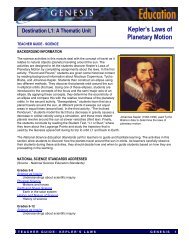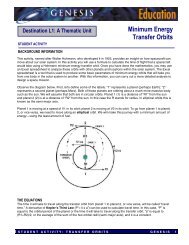A Historic Overview: Mendeleev and the Periodic Table - Genesis
A Historic Overview: Mendeleev and the Periodic Table - Genesis
A Historic Overview: Mendeleev and the Periodic Table - Genesis
You also want an ePaper? Increase the reach of your titles
YUMPU automatically turns print PDFs into web optimized ePapers that Google loves.
<strong>Mendeleev</strong>In <strong>the</strong> mid-1800s, most chemists worldwide were convinced that <strong>the</strong> elements existed in families that had similar physical<strong>and</strong> chemical properties. However, <strong>the</strong>re was no widely accepted chart that explained relationships in chemicalproperties among chemical groups. The periodic table, an information organizing tool that we take for granted today,began as a simple question in <strong>the</strong> mind of a Russian scientist, Dmitrii I. <strong>Mendeleev</strong> (1843-1907). What is <strong>the</strong> relationshipof <strong>the</strong> elements to one ano<strong>the</strong>r <strong>and</strong> to <strong>the</strong> chemical families to which <strong>the</strong>y belong?<strong>Mendeleev</strong>'s passion for underst<strong>and</strong>ing <strong>the</strong> families of elements took him into previouslyuncharted territory. He felt that <strong>the</strong> newly understood atomic mass measurementswould have greater significance once scientists clearly understood <strong>the</strong> relationshipsamong <strong>the</strong> elements. <strong>Mendeleev</strong> wrote his ideas into <strong>the</strong> chemistry textbooks fromwhich he taught. In Principles of Chemistry, published in 1869, <strong>Mendeleev</strong> introduced aconcept he called <strong>the</strong> <strong>Periodic</strong> Law that stated:The properties of <strong>the</strong> elements are a periodic function of <strong>the</strong>ir atomic weights.He subsequently published several versions of a periodic table of <strong>the</strong> elements, including all elements known at thattime. How was <strong>Mendeleev</strong> able to chart <strong>the</strong> relationships among <strong>the</strong> 63 known elements? It all started in a game ofcards.A Game of CardsIn order to underst<strong>and</strong> <strong>the</strong> properties of <strong>the</strong> known elements <strong>and</strong> <strong>the</strong>ir relationships to one ano<strong>the</strong>r, <strong>Mendeleev</strong>developed a card game. He wrote out <strong>the</strong> properties of each element on a different card <strong>and</strong> spent a great deal of timearranging <strong>and</strong> rearranging <strong>the</strong>m. He was looking for patterns or trends in <strong>the</strong> data on <strong>the</strong> cards. His friends called thisgame “Patience.”<strong>Mendeleev</strong> first arranged all <strong>the</strong> cards from lowest to highest atomic mass. The lightest element known in <strong>Mendeleev</strong>’stime was hydrogen. Its properties were not like any o<strong>the</strong>r known element. So <strong>Mendeleev</strong> decided to leave it out of hisgame.Scientists who are initially struggling to underst<strong>and</strong> a large mass of data commonly ignore, at least for a time, those datapoints that seem too different from <strong>the</strong> o<strong>the</strong>rs. These unusual instances are termed outliers. Whe<strong>the</strong>r or not outlierscan eventually be explained by a model often makes or breaks <strong>the</strong> scientific <strong>the</strong>ory from which <strong>the</strong> model derives.The second lightest element known to <strong>Mendeleev</strong> was lithium.HWe now know that <strong>the</strong> second lightest element, betweenhydrogen <strong>and</strong> lithium, is helium. But helium was notdiscovered on earth until 1895.So <strong>Mendeleev</strong> started his game with <strong>the</strong> element lithium.LiBeBCNOFG E N E S I S 2













